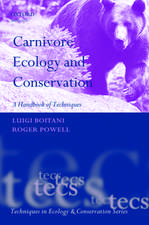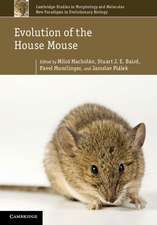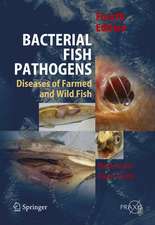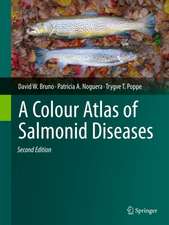Biology of the Integument: 2 Vertebrates
Editat de J. Bereiter-Hahn, A.G. Matoltsy, K. S. Richardsen Limba Engleză Paperback – 3 dec 2014
| Toate formatele și edițiile | Preț | Express |
|---|---|---|
| Paperback (2) | 674.42 lei 6-8 săpt. | |
| Springer Berlin, Heidelberg – 3 dec 2014 | 674.42 lei 6-8 săpt. | |
| Springer Berlin, Heidelberg – 19 iul 2012 | 976.86 lei 6-8 săpt. |
Preț: 674.42 lei
Preț vechi: 793.43 lei
-15% Nou
Puncte Express: 1012
Preț estimativ în valută:
129.09€ • 140.27$ • 108.51£
129.09€ • 140.27$ • 108.51£
Carte tipărită la comandă
Livrare economică 21 aprilie-05 mai
Preluare comenzi: 021 569.72.76
Specificații
ISBN-13: 9783662009918
ISBN-10: 3662009919
Pagini: 872
Ilustrații: XVI, 855 p.
Dimensiuni: 170 x 244 x 48 mm
Greutate: 1.36 kg
Ediția:Softcover reprint of the original 1st ed. 1986
Editura: Springer Berlin, Heidelberg
Colecția Springer
Locul publicării:Berlin, Heidelberg, Germany
ISBN-10: 3662009919
Pagini: 872
Ilustrații: XVI, 855 p.
Dimensiuni: 170 x 244 x 48 mm
Greutate: 1.36 kg
Ediția:Softcover reprint of the original 1st ed. 1986
Editura: Springer Berlin, Heidelberg
Colecția Springer
Locul publicării:Berlin, Heidelberg, Germany
Public țintă
Professional/practitionerDescriere
The integument plays an important role in the survival of meta zoans by separating and protecting them from a hostile environ ment. Its function ranges from protection against injury and in fection, participation in the regulation of body temperature and water balance, to respiratory activity, monitoring of the environ ment and production of signals related to behaviour. All these result from specific structural, biochemical and physiological properties of intra-and extracellular components of the integu ment. Thus its characterization can be best accomplished by a multidisciplinary approach with authors specialized in different fields of science. This multi-author book, in two volumes, provides an up-to date survey of the literature. The first volume deals with the integument of invertebrates, the second with that of vertebrates, both organized primarily on a phylum basis. As the level of knowledge on the integument of phyla differs considerably, the information provided is correspondingly either limited or con densed. For some of the smaller groups of invertebrates little information is available, as often only a few electron micrographs are to be found in the literature ; on the other hand, from the large body of knowledge existing for vertebrates, particularly for mammals, no complete overview can be provided, but publica tions giving access to further information have been reviewed critically.
Cuprins
I Introduction.- 1 Introduction.- II The Skin of Fishes Including Cyclostomes.- 2 Epidermis.- 3 Dermis.- 4 Pigment Cells.- III The Skin of Amphibia.- 5 Epidermis.- 6 Dermis.- 7 Dermal Glands.- 8 Pigment Cells.- IV The Skin of Reptiles.- 9 Epidermis and Dermis.- 10 Glands.- V The Skin of Birds.- 11 Epidermis, Dermis and Appendages.- 12 Colouration.- 13 Uropygial Gland.- VI The Skin of Mammals.- 14 Structure and Function of the Mammalian Epidermis.- 15 Dermis.- 16 Formation, Chemical Composition and Function of Melanin Pigments.- 17 Hair, Wool, Quill, Nail, Claw, Hoof, and Horn.- 18 Sebaceous Glands.- 19 Sweat Glands.- 20 Scent Glands.- VII Epidermal-Dermal Interaction.- 21 Epidermal-Dermal Interaction.- VIII Mammalian Epidermal Cells in Culture.- 22 Mammalian Epidermal Cells in Culture.- IX Epidermal Cell Migration and Wound Repair.- 23 Epidermal Cell Migration and Wound Repair.- X Epidermal Osmoregulation and Salt Glands.- 24 The Role of Amphibian Epidermis in Osmoregulation and Its Adaptive Response to Changing Environment.- 25 Chloride Cells and Salt Glands.- XI Thermoregulation.- 26 Thermoregulation.- XII Skin-Mediated Sensation.- 27 Mechanoreceptors and Free Nerve Endings.- 28 Thermoreceptors.- 29 Chemoreceptors.- 30 The Merkel Cell.- XIII Skin Proteins.- 31 Epidermal ?-Keratin: Structure and Chemical Composition.- 32 Epidermal ?-Keratins: Structural Diversity and Changes During Tissue Differentiation.- 33 Feather Keratin: Composition, Structure and Biogenesis.- 34 Hair Keratin: Composition, Structure and Biogenesis.- 35 Nail, Claw, Hoof and Horn Keratin.- 36 Keratohyalin.- 37 Involucrin: A Constituent of Cross-Linked Envelopes and Marker of Squamous Maturation.- 38 Desmosomal Proteins.- 39 Protein Components of the Epidermal Basement Membrane.- 40 Interstitial Collagens.- 41 Elastic Fibers.- XIV Skin Lipids.- 42 Lipids of Keratinizing Tissues.- 43 Sebaceous Gland Lipids.- 44 Preen Gland and Scent Gland Lipids.- Index to Genera.















